One of the best ways to really discover Venice is to meander without a plan. It sounds obvious and a complete cliche, but it’s actually true. Go to the vaporetto stop and get on the first boat that comes along, get off the boat when you feel like it and then just wander. See what happens.
Let’s take San Zaccaria as an example. The waterfront here is always teaming with people. It’s always been like this. Carlo Goldoni, the Venetian playwright wrote about arriving here at two o’clock in the morning in the 1740s and observing that it was as busy as midday, people chatting and drinking, gambling and cavorting. Today it’s still crowded, tour groups and souvenir stalls, Murano glass salesmen and packed cafes selling over-priced drinks and mediocre food. And yet, and yet….. stroll one hundred paces from the waterfront and you are in Campo San Zaccaria, with the gleaming white facade of the church of San Zaccaria smiling down on you. This was the most important church in Venice, before the construction of St Mark’s. The body of John the Baptist’s father, Zaccaria, lies within the church. When you go inside the church, it’s usually quite dark and gloomy and empty! On the left hand side there’s a painting by Giovanni Bellini – it’s a masterpiece. All you have to do is pop a euro coin in the box and the painting is illuminated, in all it’s 16th century glory.
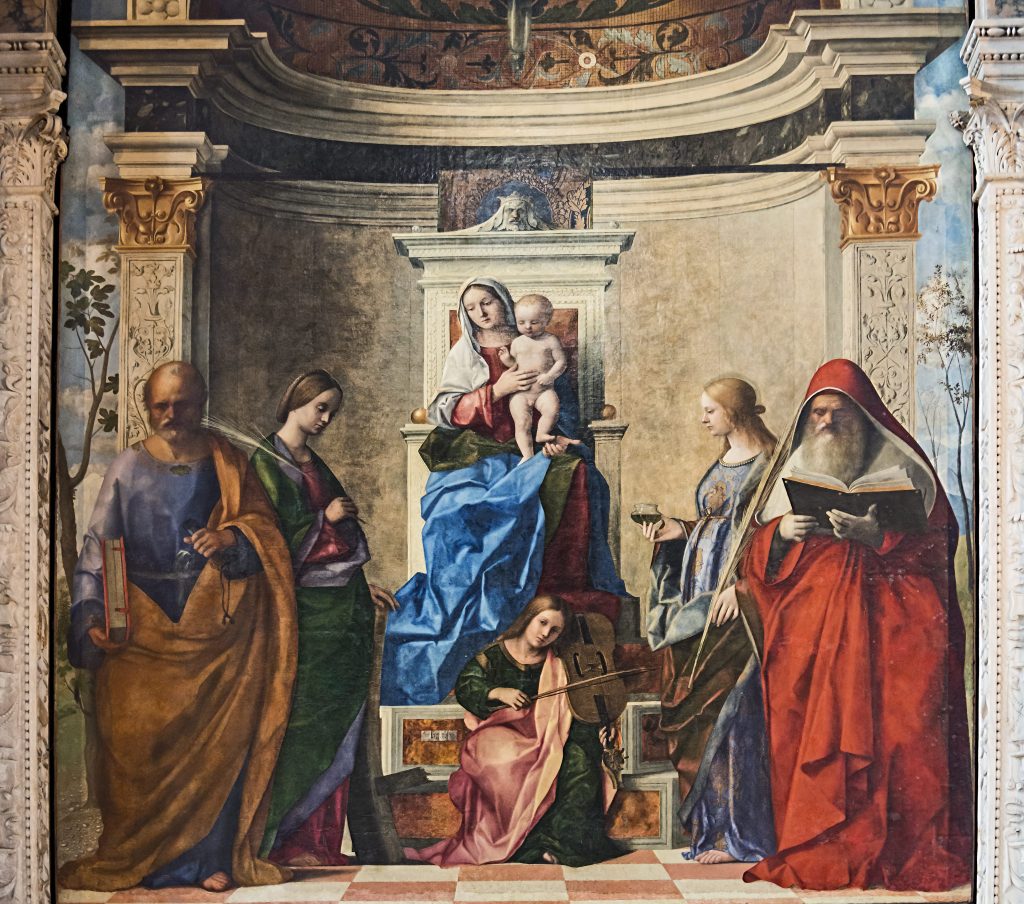


Bellini Masterpiece – San Zaccaria, Venezia – 1505 – Madonna and Child and saints – photos by Mark Caplan and www.greyhoundtrainers.com
The painting shows the Madonna and child flanked by the saints, Peter and Catherine to the left and Lucy and Jerome to the right. A child plays a violin in the centre of the painting. The architectural details are precise, arches, pillars and columns, a tiled floor, even a glimpse of the Venetian countryside in the distance. Each saint has a particular story. Peter with his keys, the symbol of his entry into the ‘kingdom of heaven’. Catherine depicted with the breaking wheel, with which she was tortured for her Christian faith. To the right of the painting there’s Lucy, another early Christian martyr with her eyes in a bowl. Then next to her is the bearded St Jerome, a learned and scholarly figure.
Giovanni Bellini was from a family of brilliant Venetian artists, his father Jacopo and his brother Gentile both played important roles in the artistic world of Venice. Gentile Bellini painted a number of important events in Venice, including the spectacularly detailed ‘Miracolo della reliquia della Croce al ponte di San Lorenzo’ which is now in Venice’s Accademia Art Gallery. This painting has been recently restored. The clarity of the water and the ghost like, ethereal characters (angels?) swimming in the water are almost magical in quality. Magical, compelling. It’s only a 20 minute walk from San Zaccaria to the Accademia, so perhaps the time is right to visit Venice’s finest collection of historic paintings in an art gallery setting.
But first a little more on that Miracle of the ‘relic of the holy cross’ at the Bridge of San Lorenzo. Just who are all those people in the water (see below)? Well, The picture is rich in detail and shows a procession day when the ‘relic of the true cross’ donated to the Venetians in 1369, accidentally falls into the canal. Immediately various people jump into the water to rescue this priceless relic. However the honour of retrieving the cross goes to the hero of the hour Andrea Vendramin who just happens to be from a very noble Venetian family and is also boss man of the Guild (Scuola) who had commissioned the painting in the first place. The lady on the left (front of painting in green velvet and gold) is thought to be Caterina Cornaro – Queen of Cyprus. Whilst the gents on the right are thought to be high ranking members of the guild and possibly a pair of Bellini brothers! The woman on the right of the painting, at the side of the canal appears to be ‘encouraging’ her Moorish slave to jump into the water to retrieve the cross. Certainly the painting is action-packed. Bellini’s ability to convey colour and lucidity to the waters of the canal creates a compelling, translucent element to the watery foreground. The crowds lining the canal represent noble men and women, clergy, monks in their white habits and a selection of boatmen surveying the scene. For a painting dating from 1500 this is an extraordinarily detailed piece of work reminiscent of the Canaletto canvases that came 250 years later.
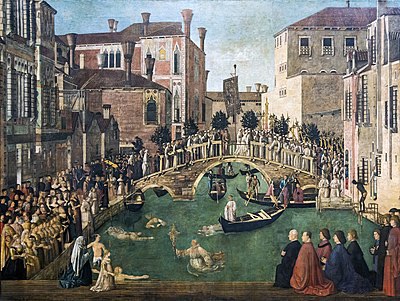
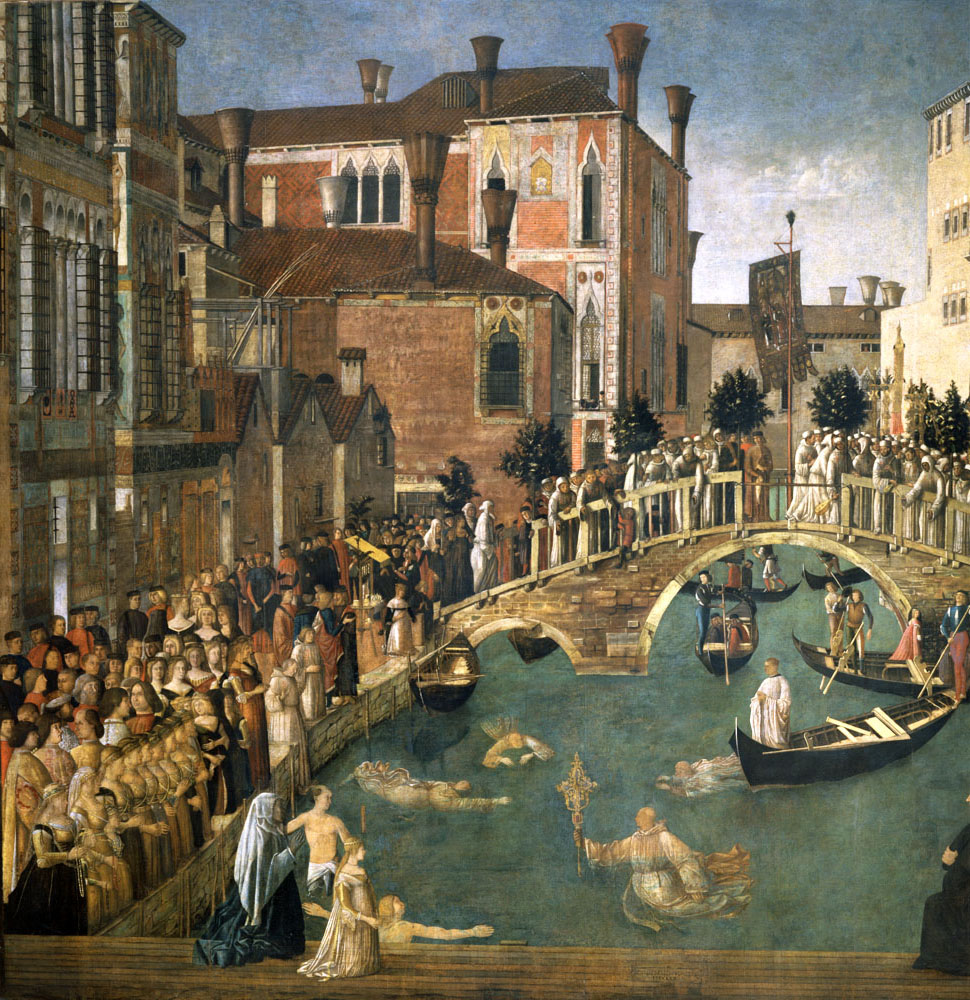
‘Miracle of the Cross at the Bridge of S. Lorenzo‘ by artist Gentile Bellini c.1500. It is now housed in the Gallerie dell’Accademia
Now, because everything is linked to everything else in Venice – it’s not possible to think about early 16th century art without considering the amazing Vittore Carpaccio who created many stunning and also humorous paintings. Favourites of mine are St Jerome with his tamed lion (1502) with the unique architecture of Venice in the background and allusions to Bethlehem at the same time. Then, of course, The Vision of Sant’ Agostino, also 1502. Both paintings can be seen in the Scuola S Giorgio – just a five minute trot from San Zaccaria.
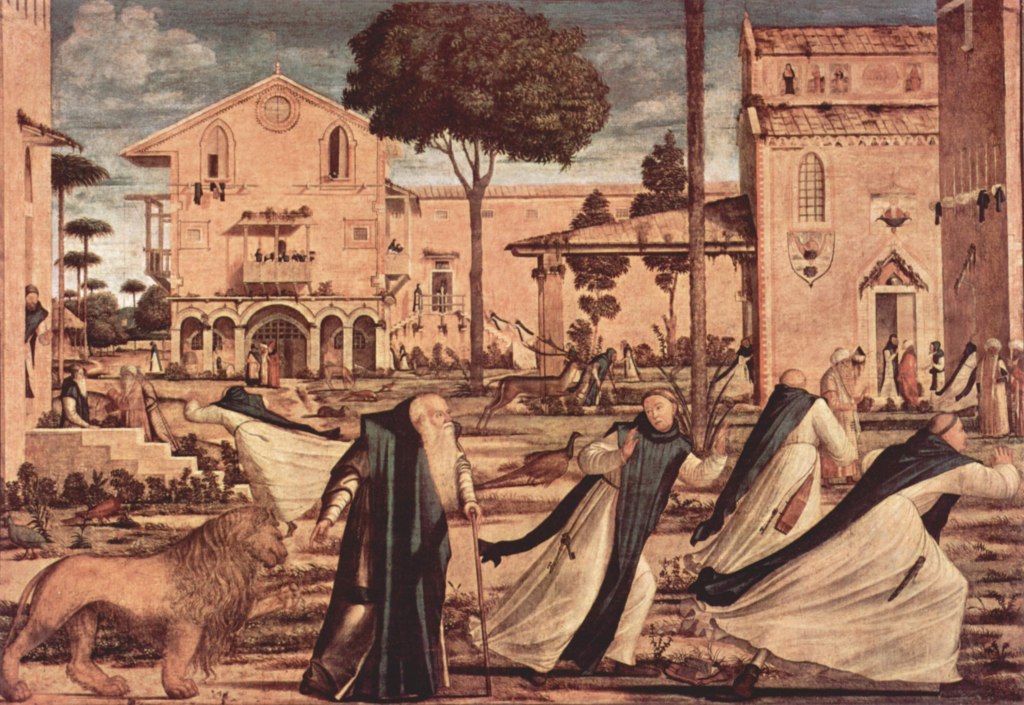

Meanwhile, if you’ve actually made it to the Accademia and admired Gentile Bellini’s ‘Miracle of the True Cross at San Lorenzo’ you’ll probably want to extend your stay and enjoy Giorgione’s amazing ‘The Tempest’.
Giorgione’s canvas ‘The Tempest’ painted in 1506 and commissioned by Gabriele Vendramin, brother of the Venetian Doge Andrea Vendramin is another exceptional painting in Venice’s rich history. The painting is a rural, countryside scene, a far cry from the religious paintings that dominated the period. The walls of Castelfranco Veneto (Giorgione’s home town) are clearly visible in the painting. A young woman nurses a child, the white cape suggests innocence, perhaps she’s the Madonna in a contemporary setting. The young man on the left is perhaps a shepherd, a herder of men, perhaps? Giorgione also shows storm clouds in the sky, a sign of change in the air? The painting is elemental, evocative and dramatic. The weather and impending storm is like a character in the canvas. Powerful and compelling. Don’t forget this painting is from 1506 – more than five centuries ago.
When you emerge from the Accademia it is just a five minute walk to the Zattere. Here you can enjoy wonderful views of the lagoon and Giudecca. Also the sunsets are spectacular. Enjoy an aperitivo or an ice cream at Nico’s Gelateria. Just divine. If you still have an appetite for art there’s actually a Botticelli just around the corner – seriously! That’s in Palazzo Cini (five minutes walk)! Perhaps that is for another day.
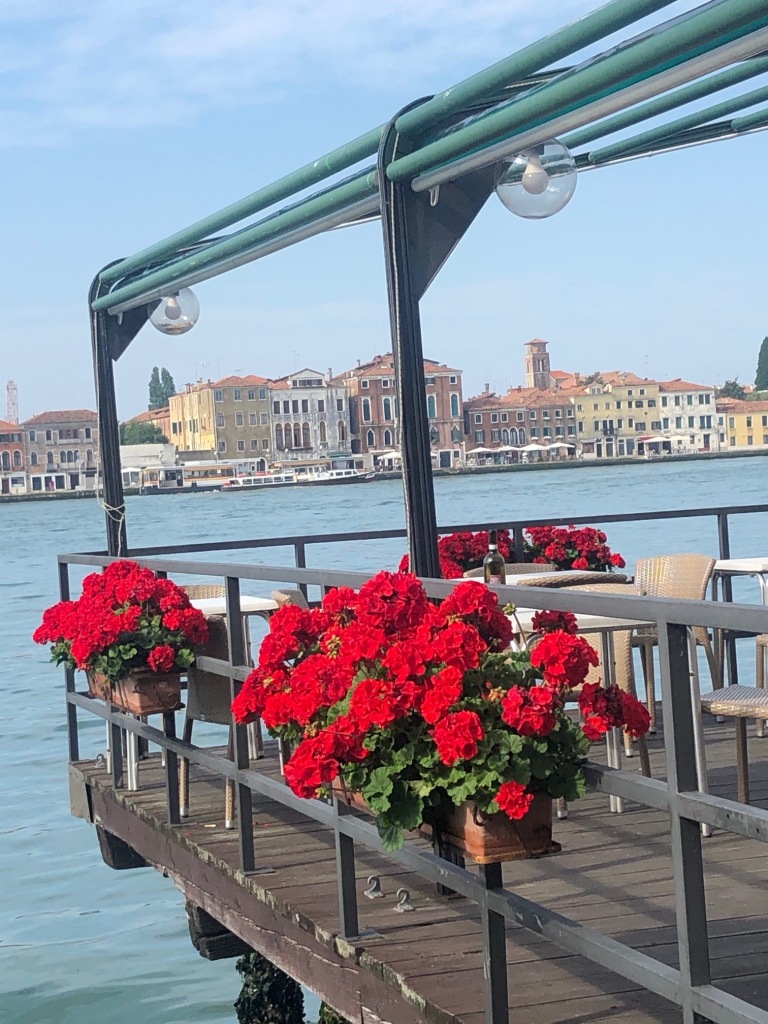
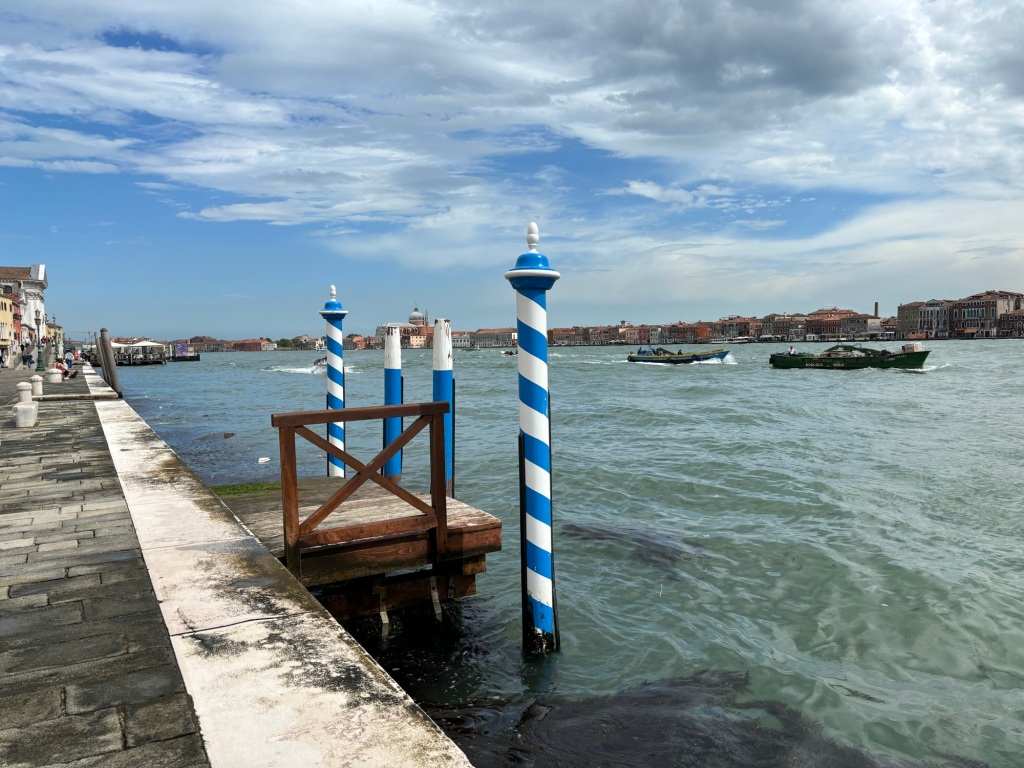

Views across from Zattere to Giudecca – perfect for an aperitivo. Photos: www.greyhoundtrainers.com
A useful map – for your stroll if you prefer not to meander:
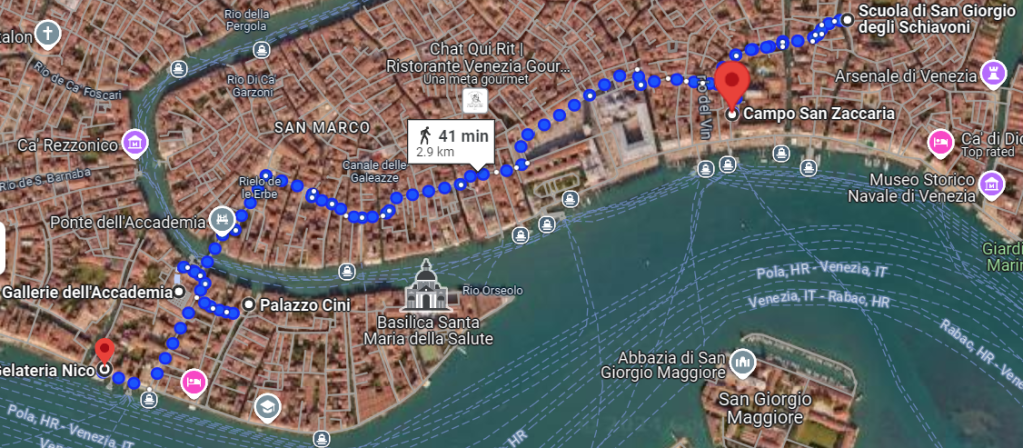
FURTHER READING – articles I’ve written over the last couple of years:
- St Catherine of Alexandria
- Santa Lucia
- Venice – there’s treasure in every church
- Vittore Carpaccio – Venice painter & genius
- Orientalism in Venetian Art
- Venice – Botticelli in Venice – seriously?
- Botticelli (1445-1510) was mostly active in Florence. His ‘Judgement of Paris’ painting arrived in Venice much later possibly in the 19th century. It is now on show in the Renaissance Room of Palazzo Cini. www.palazzocini.it
A NOTE ON THE AUTHOR – Janet Simmonds (nee Panagakis) is a British-born tour guide, writer and travel company owner. Born in Liverpool with a slightly Greek grand-father and a very Greek great grand-father she has a special affinity with the history, culture and art of the Mediterranean, especially Italy and Greece. She studied Geography and Art History at the Universities of Oxford and Manchester, Janet has spent most of her adult life running specialist travel companies and travelling extensively. Several times a year she leads small groups to different parts of Europe. Mostly to Venice, Trieste, Friuli, Naples, Basilicata, Amalfi and Sicily. Occasional trips to Greece, especially Athens, Delphi and Thessalonika are usually on the horizon. Next year it’s Istanbul and the Lycian tombs of Antalya, Turkey.
In 2024-2025 – why not travel with us:
- Janet writes about her travels on her blog: www.greyhoundtrainers.com
- She is also the owner of specialist travel company Grand Tourist which offers unique, tailor-made travel for individuals, couples and small groups.
- The web site is www.grand-tourist.com
- Ask us for our programme of tours in 2025: janet@grand-tourist.com
Written & published: September 2024
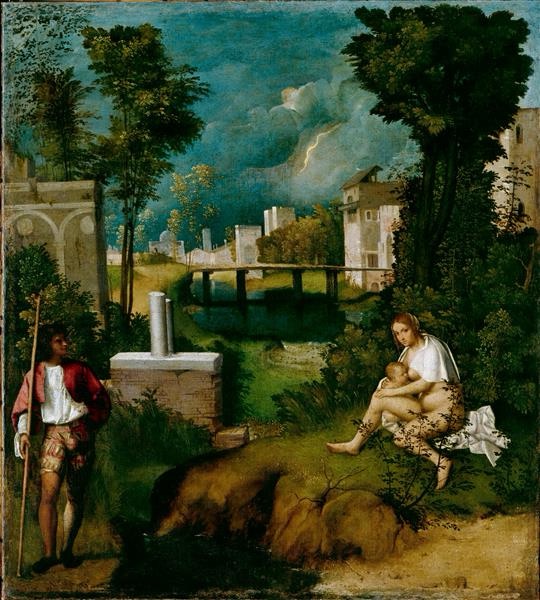

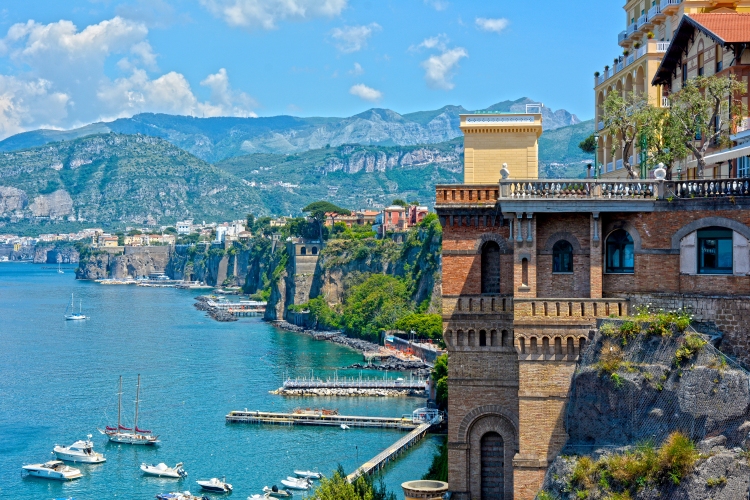


I remember my unfortunately brief visit to Venice; I was astounded at the artwork. I hadn’t realized that the Europeans had been keeping so much of the best art for themselves.
LikeLike
That’s true Paul – although there are some pretty amazing European art collections in America. The Chicago Art Institute is exceptionally rich.
LikeLiked by 1 person
Do please look out for my numerous articles on art – especially in Italy. You may like my article about Orientalism in Venetian Art – here’s the link: https://wp.me/p5eFNn-67j
LikeLike